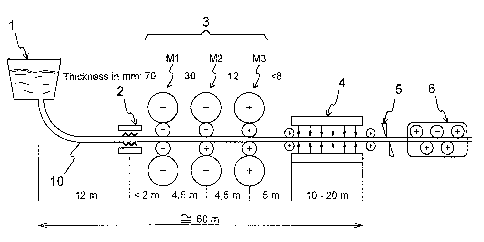Some of the information on this Web page has been provided by external sources. The Government of Canada is not responsible for the accuracy, reliability or currency of the information supplied by external sources. Users wishing to rely upon this information should consult directly with the source of the information. Content provided by external sources is not subject to official languages, privacy and accessibility requirements.
Any discrepancies in the text and image of the Claims and Abstract are due to differing posting times. Text of the Claims and Abstract are posted:
| (12) Patent: | (11) CA 2611390 |
|---|---|
| (54) English Title: | PROCESS AND PLANT FOR MANUFACTURING STEEL PLATES WITHOUT INTERRUPTION |
| (54) French Title: | PROCEDE ET INSTALLATION POUR FABRIQUER DES PLAQUES D'ACIER SANS INTERRUPTION |
| Status: | Deemed Expired |
| (51) International Patent Classification (IPC): |
|
|---|---|
| (72) Inventors : |
|
| (73) Owners : |
|
| (71) Applicants : |
|
| (74) Agent: | GOWLING WLG (CANADA) LLP |
| (74) Associate agent: | |
| (45) Issued: | 2012-05-15 |
| (86) PCT Filing Date: | 2005-07-19 |
| (87) Open to Public Inspection: | 2007-01-25 |
| Examination requested: | 2010-02-18 |
| Availability of licence: | N/A |
| Dedicated to the Public: | N/A |
| (25) Language of filing: | English |
| Patent Cooperation Treaty (PCT): | Yes |
|---|---|
| (86) PCT Filing Number: | PCT/IT2005/000412 |
| (87) International Publication Number: | IT2005000412 |
| (85) National Entry: | 2007-12-05 |
| (30) Application Priority Data: | None |
|---|
Process and related plant for manufacturing steel plates with thickness < 100
mm and width of up to 4000 mm from a continuous casting step (1) for slabs
(10), comprising a liquid core reduction step, without interruptions until
completion of a finishing rolling step (3) with high reduction ratios in at
least one stand. The average temperature when entering the rolling step is >=
1250~C, but can be reduced for unalloyed or low alloyed steel greatest.
L'invention concerne un procédé et une installation associée pour fabriquer des plaques d'acier présentant une épaisseur inférieure à 100 mm et une largeur allant jusqu'à 4000 mm. Ce procédé comporte une étape de coulage continue (1) destinée à obtenir des plaques (10), cette étape (1) comprenant une étape de réduction de noyau liquide, sans interruptions, jusqu'à la fin d'une étape de laminage de finition (3) présentant des rapports de réduction élevés sur au moins un poste. La température moyenne au début de l'étape de laminage est supérieure ou égale à 1 250 °C, mais peut être réduite pour un acier pur ou faiblement mélangé.
Note: Claims are shown in the official language in which they were submitted.
Note: Descriptions are shown in the official language in which they were submitted.

2024-08-01:As part of the Next Generation Patents (NGP) transition, the Canadian Patents Database (CPD) now contains a more detailed Event History, which replicates the Event Log of our new back-office solution.
Please note that "Inactive:" events refers to events no longer in use in our new back-office solution.
For a clearer understanding of the status of the application/patent presented on this page, the site Disclaimer , as well as the definitions for Patent , Event History , Maintenance Fee and Payment History should be consulted.
| Description | Date |
|---|---|
| Letter Sent | 2024-01-19 |
| Letter Sent | 2023-07-19 |
| Common Representative Appointed | 2019-10-30 |
| Common Representative Appointed | 2019-10-30 |
| Change of Address or Method of Correspondence Request Received | 2018-01-10 |
| Grant by Issuance | 2012-05-15 |
| Inactive: Cover page published | 2012-05-14 |
| Pre-grant | 2012-02-29 |
| Inactive: Final fee received | 2012-02-29 |
| Notice of Allowance is Issued | 2012-02-01 |
| Letter Sent | 2012-02-01 |
| Notice of Allowance is Issued | 2012-02-01 |
| Inactive: Approved for allowance (AFA) | 2012-01-30 |
| Amendment Received - Voluntary Amendment | 2011-09-26 |
| Inactive: S.30(2) Rules - Examiner requisition | 2011-05-09 |
| Letter Sent | 2010-03-15 |
| Request for Examination Requirements Determined Compliant | 2010-02-18 |
| All Requirements for Examination Determined Compliant | 2010-02-18 |
| Request for Examination Received | 2010-02-18 |
| Amendment Received - Voluntary Amendment | 2008-04-01 |
| Inactive: Cover page published | 2008-03-03 |
| Inactive: Notice - National entry - No RFE | 2008-02-28 |
| Inactive: Inventor deleted | 2008-02-28 |
| Inactive: First IPC assigned | 2008-01-05 |
| Application Received - PCT | 2008-01-04 |
| National Entry Requirements Determined Compliant | 2007-12-05 |
| Application Published (Open to Public Inspection) | 2007-01-25 |
There is no abandonment history.
The last payment was received on 2011-06-29
Note : If the full payment has not been received on or before the date indicated, a further fee may be required which may be one of the following
Patent fees are adjusted on the 1st of January every year. The amounts above are the current amounts if received by December 31 of the current year.
Please refer to the CIPO
Patent Fees
web page to see all current fee amounts.
Note: Records showing the ownership history in alphabetical order.
| Current Owners on Record |
|---|
| GIOVANNI ARVEDI |
| Past Owners on Record |
|---|
| None |